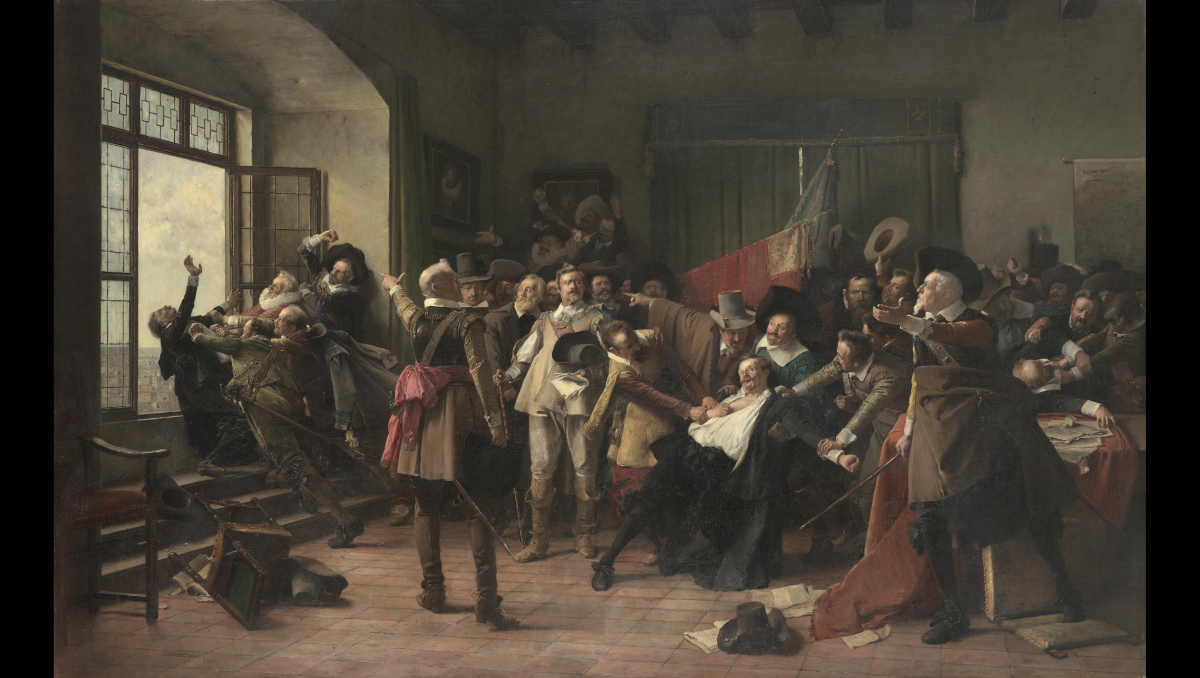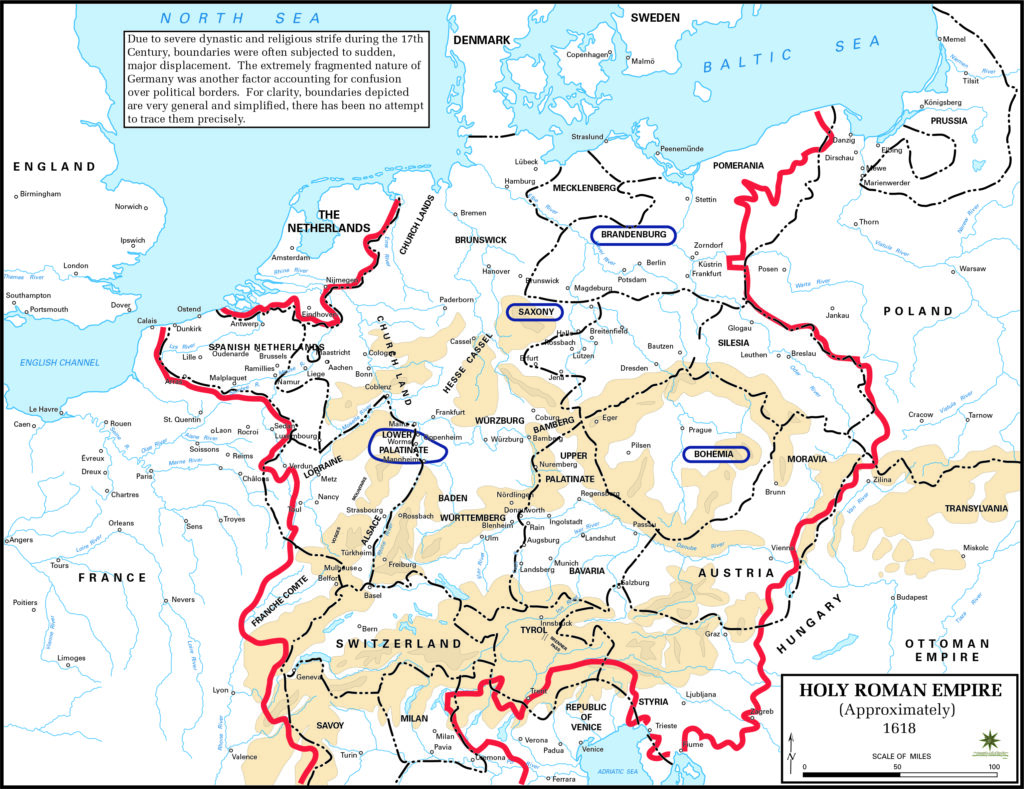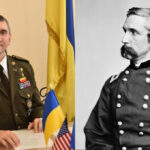
It was a highly complex conflict, conducted primarily in what is now Germany, from 1618-1648
The Thirty Years War is remote in both time and place for most Americans. It was exceptionally complicated, caused immense suffering, and its resolution foreshadowed modern diplomacy and the “Westphalian” system of sovereign states. Although this intriguing topic is not in the curriculum at the U.S. Army War College (where it has been my privilege to teach), it has much to offer. Here then is a modest effort to digest it in terms useful to students of national security.

What was the Thirty Years War?
It was a highly complex conflict, conducted primarily in what is now Germany, from 1618-1648; historian Myron Gutman describes it as ” not one but three wars, with six or more principal parties.” Its multiple roots lay in the breakup of the Roman empire, the power of the Church, the Reformation and incipient tension between faith and reason, the decline of feudalism, competing concepts of law and freedom, dynastic competition, and stirring nationalism. From modest beginnings, the conflict engaged Europe for decades, passing through distinct phases and squandered opportunities for peace along the way. Armies in the war fought in, lived off, and destroyed the lands of Bohemia and north Germany during prolonged campaigns with utter disregard for most of the population (see The Thirty Years War, CV Wedgwood).
How did it arise? Who were the principal actors?
A brief survey might begin with the papal crowning in 800 A.D. of Charlemagne as emperor of Rome; by this ceremony he theoretically inherited the authority of the Caesars. His vast domains would eventually take on the name of the “Holy Roman Empire.” After 1452 the Habsburg family took control (which they kept until Napoleon’s time). In 1618 the Empire controlled the heart of Europe from Rome to Denmark and from Monaco to Lithuania. It was elaborate in form, comprising over 300 imperial estates (a few large principalities or kingdoms along with many small estates, knightly orders, free cities and villages, and imperial abbeys), all claiming a degree of autonomy.
Association with the Catholic Church added to the Empire’s legitimacy. By the sixteenth century, however, many critics excoriated the Church for unsavory practices–its accumulation of wealth, sale of indulgences, sexual license by priests, political engagement, and corruption–and took issue with key theological concepts, including transubstantiation, infant baptism, intercession of saints, and purgatory. Martin Luther and others contested Church authority except when explicitly linked to scripture; they sparked the Protestant Reformation, which spread rapidly in various forms across northern and western Europe. This provoked counter-reform and repression from the Church and its royal supporters, leading to violent conflicts of Protestant sects against Catholics, and each other.
Holy Roman Emperor Charles V had aspired to revive the medieval concept of universal monarchy aligned with the Church but reluctantly consented in 1555 to the Peace of Augsburg, which established the celebrated principle of cuius regio, eius religio (a Latin phrase meaning “whose realm, his religion”). This permitted rulers to choose either Lutheranism or Catholicism as the official religion in their territory. Charles V then abdicated, dividing Habsburg domains between his son, King Philip II of Spain, and his brother Ferdinand I, the new Holy Roman Emperor.
Philip II’s domains included the Seventeen Provinces (today’s Netherlands and Belgium), but in 1568 these rebelled, beginning the Eighty Years War. A few years later, seven provinces gained de facto independence as the Dutch Republic, though war continued; the others remained under Spanish rule. The Protestant-led Dutch Republic signed a twelve-year truce with Spain in 1609.
Ferdinand I’s domains were the German-speaking territories and their neighbors. A deeply pious Catholic, he was anxious to consolidate his authority within the empire. He embraced legal and administrative reforms meant to strengthen control over the empire’s 300-plus estates; these included adoption of Roman law, which differed in important ways from German tradition. The reforms led to conflicts with the estates (Wedgwood p. 56).
Habsburg emperors were powerful, but their ascension to the throne rested on votes from the seven German prince-electors who comprised the electoral college; these were the archbishops of Mainz, Trier, and Cologne, and the secular rulers of Bohemia, Saxony, Brandenburg, and the Palatine. These electors and other rulers of imperial estates treasured their “German Liberties“—privileges including, inter alia, the right to make alliances, autonomy in dynastic affairs, and precedence over other subjects. The Palatine elector, in particular, was to play a critical role in the Thirty Years War.
By 1618, the stage was set for parallel conflicts:
– German princes and towns sought to preserve legal and religious privileges and autonomy from the emperor.
– Ferdinand II wanted greater centralization of the empire, maintenance of Catholic privileges and suppression of Protestants, and defense against encroaching foreign powers, along with support to the Spanish Habsburgs.
– Sweden and Denmark, Lutheran powers with strong kings, had territorial and religious ambitions in the German lands.
– France, a Catholic country with a large Protestant minority, sought to prevent the emergence of a strong and united power in German lands.
– A declining Spain retained a powerful military; it wanted safe passage up the Rhine for its arms and money to subdue that part of the Netherlands still under Spanish control.
– The rising Dutch Republic, built on thriving commerce and naval strength, wanted to preserve its independence.
– The Popes supported the Empire, but sometimes feared Habsburg growth as prejudicial to their temporal interests. This was especially true of the pro-French Pope Urban VIII.
A year later, Protestant rebels threw the regents out of a high window of Prague Castle (the famous Defenestration of Prague) and began an armed uprising, which soon besieged Vienna.
How did it begin? What were the principal events?
Ferdinand II’s predecessors had confirmed freedom of worship to Protestants in Bohemia. When Ferdinand became King of Bohemia in 1617, he left unpopular Catholic regents to govern in his absence. A year later, Protestant rebels threw the regents out of a high window of Prague Castle (the famous Defenestration of Prague) and began an armed uprising, which soon besieged Vienna. In 1619, the Bohemian estates deposed Ferdinand as King of Bohemia and elected in his place the Protestant Frederick V–the Elector Palatine–who threw in his lot with the uprising. He was defeated by imperial allies in 1620, and fled. The war might have ended there, but Frederick remained stubborn, his army remained active, and Spanish Habsburg forces continued to occupy Bohemia (Wedgwood p. 130).
In 1621 the truce between Spain and the Dutch Republic expired, and the Dutch offered support to the exiled Frederick. Emperor Ferdinand, seeking to restore the Church to its earlier status, banned Protestant ceremonies, expelled Protestant pastors, and ordered religious conversion of all Protestants in Upper Austria. The German princes became divided; few supported Frederick, but none wanted foreign occupation, nor any imperial encroachment on their liberties. In 1629 the emperor issued the Edict of Restitution, calling for restoration to the Church of all lands it had held at the time of the Peace of Augsburg, many of which had passed into Protestant hands over the years. These moves were deeply provocative to Protestants and sharply expanded the conflict.
In 1630 Swedish king Gustavus Adolphus–a brilliant soldier and pious Lutheran with territorial and religious motives for intervening–invaded Pomerania, marking a new phase to the war. After considerable success he was killed in late 1632. His death, and that of Elector Frederick in the same year, threw German politics into what one historian called “a heap of shards” (Wedgwood p. 332). The war now became one of dynasties, as Bourbon France supported the Dutch against Habsburg Spain and sought to displace the Habsburgs as the principal power on the west bank of the Rhine. In 1635 the emperor signed the Peace of Prague, attracting rapid support from nearly all German rulers. With this agreement, Ferdinand II effectively conceded the restoration of cuius regio, eius religio, thus ending the religious aspect of the war. The imperial estates accepted the emperor’s supremacy, enabling the consolidation of Habsburg power within the empire. This marked the high point of Austrian imperial power in German lands. Still, the war was to continue for another thirteen years, almost entirely between France and Spain, but fought largely in Germany.
How did it end?
The war concluded in 1648 with three treaties signed in the Westphalian towns of Munster and Osnabruck. The treaties ended the Eighty Years War between Spain and the Dutch, on the one hand, and between the Empire, France, and Sweden on the other. The negotiations took years and involved participation of more than a hundred delegations, residing in various locations far apart.
The peace did not resolve everything; France and Spain continued their war for another decade. Nor were all parties satisfied; Pope Innocent X, unable to accept concessions made to Protestants, notoriously called the settlement “null, void, invalid, iniquitous, unjust, damnable, reprobate, inane, empty of meaning and effect for all time.”
What was its significance?
The war was legendarily vicious, bringing disease, pestilence, starvation, and the depredations of soldiers. The sack of Magdeburg in 1631 became notorious: birds of prey and dogs thrived on corpses, the river teemed with charred bodies, and “Magdeburg quarter” became a synonym for massacre. For the war as a whole, modern estimates of the dead range between 5 and 8 million (mostly civilian) at a time when the total population of the empire at the outset was some 21 million. It would not regain pre-war population levels for a century.
Some boundaries changed. Alsace and part of Pomerania changed hands, and the Dutch Republic and Switzerland obtained formal independence, though this had been a practical reality long before. Habsburg Austria was weakened. German princes rose in relative power and became estranged from Austria, sowing seeds instead of the future Prussia. Spain’s army was destroyed, making way for France to become dominant in Europe, though Spain retained possession of what is today Belgium.
The peace did not end the religious conflicts of the Reformation era across Europe, but it did mark an important turning point. After 1648 there could be little hope of eradicating Protestantism from northern Europe, or of reconciling Protestant sects to the authority of the Church. Catholic France, whose policy was directed by a prince of the church in Cardinal Richelieu, made common cause with Protestant dominions against the Holy Roman Empire and the popes. Such placing of regime interests over loyalty to the faith marked the beginning of what would be called raison d’etat (Wedgwood Ch 1). Henry Kissinger set his discussion of Richelieu’s masterful diplomacy in this context. He considered Richelieu the father of the modern state system, replacing medieval universal moral principles with raison d’etat, and delaying German unification by more than two hundred years. Most importantly for our War College students, scholars generally consider the Peace of Westphalia to be the foundation of the modern international system emphasizing sovereign states and the principle of non-interference in each other’s internal affairs. This conception emphasizes the contrast between pre-war aspirations for a universal Christian monarch, and post-war reality of strengthened individual units (such as principalities and free cities) and weakened central authority; it highlights the success of Protestants in contesting religious uniformity, and the willingness of powers such as France to place secular interests over faith. Westphalia may also have given rise to modern diplomacy. Although there are some contraryviews, James Nathan represents the common interpretation, in Soldiers, Statecraft, and History, in which he argues that prior to the Westphalia settlement “there was no recognizable diplomatic profession” and describes Westphalia as the first meeting of the “classic” period of international diplomacy, which arranged for “what we would now call collective security.”
Christopher Sandrolini is a career Foreign Service Officer with the United States Department of State, currently assigned to the faculty of the U.S. Army War College in Carlisle, PA, as a member of the Department of National Security and Strategy. He joined the Foreign Service in 1984 and has been assigned to the Dominican Republic, New Delhi, India; Bratislava, Slovakia; Principal Officer in Calcutta, India; Deputy Chief of Mission and chargé d’affaires a.i. at the U.S. Embassy to the Holy See in Rome, Italy; Director of the International Narcotics and Law Enforcement Assistance program in Jerusalem; Deputy Chief of Mission and chargé d’affaires a.i. in Barbados and the Eastern Caribbean; and Director of the INL program in Kabul, Afghanistan. In 2022 he served temporarily at Fort Knox, supporting the Army’s Colonels Command Assessment Program; in 2023 he served for four months as Deputy Chief of Mission at Embassy Port Moresby.
The views expressed in this article are those of the author and do not necessarily reflect those of the U.S. Army War College, the U.S. Army, or the Department of Defense.
Photo Description: Painting by Václav Brožík from 1890 depicting the third defenestration of Prague
Photo Credit: Václav Brožík, Melbourne, National Gallery of Victoria, International Painting.





From the concluding paragraph of our article above:
“Most importantly for our War College students, scholars generally consider the Peace of Westphalia to be the foundation of the modern international system emphasizing sovereign states and the principle of non-interference in each other’s internal affairs.”
As to the effect (or, more correctly, the lack thereof?) of the Thirty Years War, and this line of thinking, on the primary opponents during the Old Cold War, consider the following from Hans Morgenthau’s, 1967, “To Intervene or Not to Intervene:”
“While contemporary interventions serving national power interests have sometimes been masked by the ideologies of communism and anticommunism, these ideologies have been an independent motivating force. This is the fourth factor which we must consider. The United States and the Soviet Union face each other not only as two great powers which in the traditional ways compete for advantage. They also face each other as the fountainheads of two hostile and incompatible ideologies, systems of government and ways of life, each trying to expand the reach of its respective political values and institutions and to prevent the expansion of the other. Thus the cold was has not only been a conflict between two world powers but also a contest between two secular religions. And like the religious wars of the seventeenth century, the war between communism and democracy does not respect national boundaries. It finds enemies and allies in all countries, opposing the one and supporting the other regardless of the niceties of international law. Here is the dynamic force which has led the two superpowers to intervene all over the globe, sometimes surreptitiously, sometimes openly, sometimes with the accepted methods of diplomatic pressure and propaganda, sometimes with the frowned-upon instruments of covert subversion and open force.”
Likewise in the post-Cold War, should we not say that we were/are involved in conflicts and competitions which are more similar to the religious wars of the seventeenth century; that is, involved in conflicts and competitions in which the opposed sides are (a) “trying to expand the reach of their respective political values and institutions and trying to prevent the expansion of the other;” herein, “finding enemies and allies in all countries, and opposing the one and supporting the other regardless of the niceties of international law?” (And, accordingly, and like in the seventeenth century and in the Old Cold War, involved in conflicts in which the Westphalian principle of non-interference in each others internal affairs was, and is, blatantly ignored/is seen as a/the true enemy/impediment?)
As to my comments immediately above, might we say that — with the election of President Trump now for a second time — the United States would now seem to have moved into a new era; one in which the U.S. (for some good and excellent “raison d’etat”/and/or other reasons?) might be moving:
a. Not to expand — but rather to abandon — our ideology, our system of government, our way of life — and our allies in relation to same. (This, much as the Soviets, vis-a-vis communism and their fellow communists, did under Gorbachev at the end of the Old Cold War?) And, thus, might be moving:
b. Not to prevent — but rather to help facilitate — the expansion of the ideologies, the systems of government, the ways of life, and the allies of our most dangerous opponents. (Again, much as the Soviets did, under Gorbachev, at the end of the Old Cold War?).
Question:
If I am correct here, then, are there good and excellent (“raison d’etat” and/or other: list, articulate these) reasons — which paid and/or in the near term might pay — magnificent/amazing “state” benefits (again, list, articulate these) — which would help explain why Gorbachev back-in-the-day — and/or President Trump currently — took/would take these such extreme actions?
(Are these not the — possible/proper — “Richelieu”/”raison d’etat” questions?)
Fantastic piece! I found it truly enlightening how you unpacked the complexity of the Thirty Years’ War—from its tangled religious, dynastic and territorial roots to its enduring relevance for modern national-security thinking. Particularly effective was how you connected the past conflict’s layered causes and outcomes with insights meaningful to today’s learners in military strategy and policy. Kudos to you for making such a profound, often daunting subject both accessible and insightful.